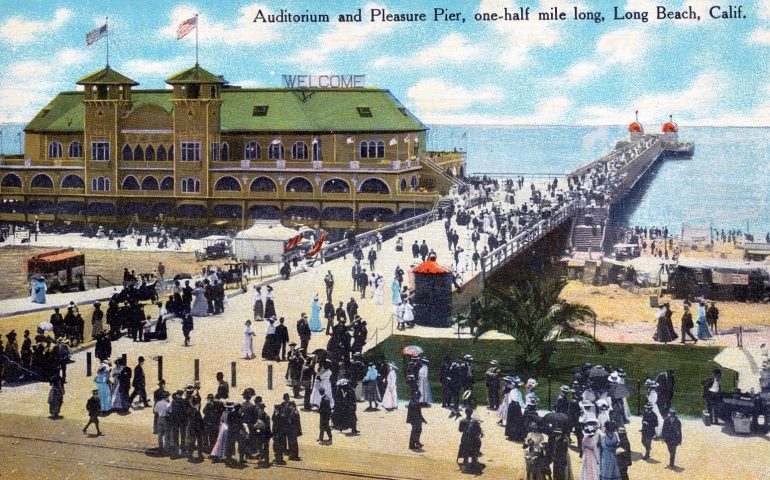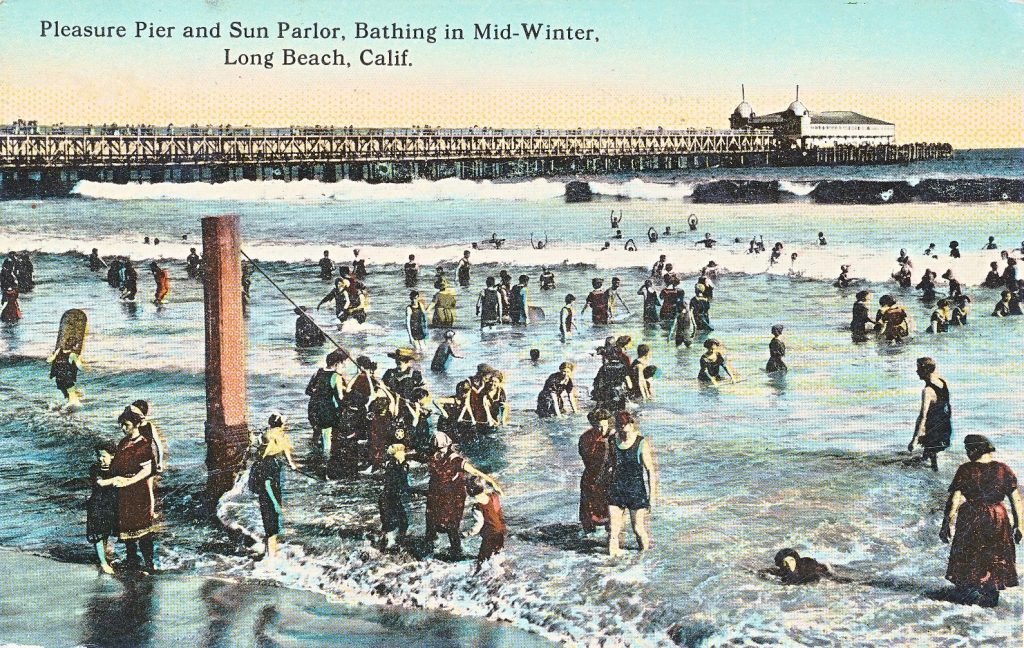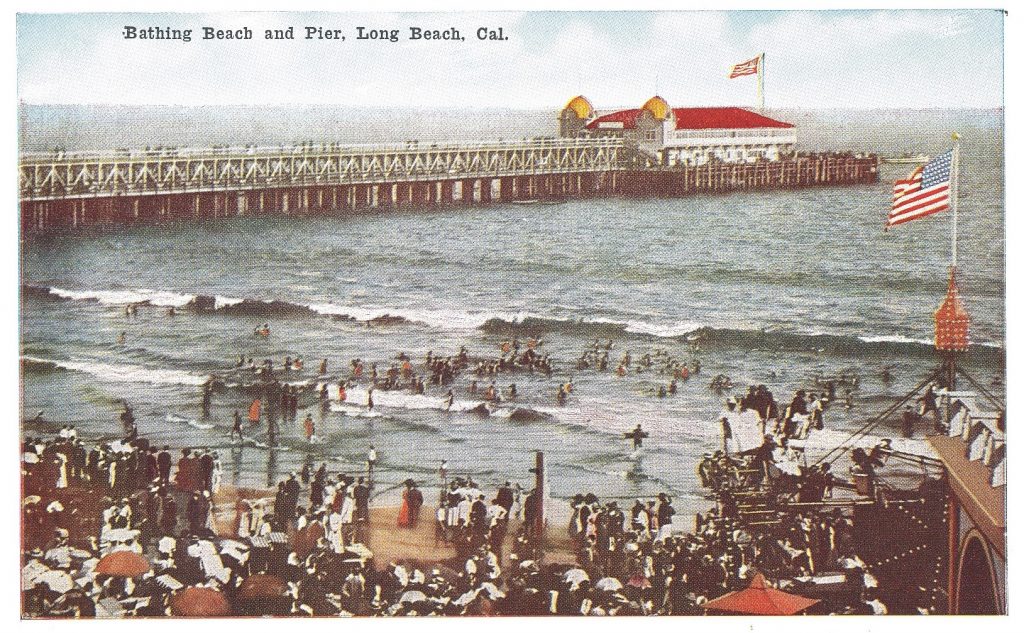Did it make sense to build a new Pine Avenue Pier? In January 1912 newspapers indicated voters would have the chance to vote on two piers, the Pine Avenue Pier and a new pier at Devil’s Gate.
On March 11, 1912, the newspaper reported that the “mad fury of a sixty mile gale tears out the south end of the pier,” the next day it recorded that a “gale is raging offshore, yet the pier still stands.”
On May 24, 1913 occurred one of the worst disasters in the history of Long Beach when a 40-foot section of auditorium at the foot of the pier collapsed. The pier, jammed with a holiday crowd, saw 36 die and an additional 174 be injured in the wreckage. A parade of people was heading out onto the pier to hear the speakers for the day when the collapse took place. Later, in order to pay for the many suits brought against the city, a special 20-cent assessment was levied against each $100 of property valuation on homeowners.
Seaside City’s Day Of Joy Is Turned To One Of Horror In Twinkling Of An Eye — Upper Deck of Great Municipal Auditorium Collapses Under Victorian Anniversary Throng of Merrymakers Hurling One Hundred and Seventy five Persons Into Splintered Abyss of Writhing Death While Shocked Thousands Watch
At the high noon of her holiday, with every street ablaze with flags of sister nations, lined with cheering thousands, and athrum with the tramp of marching feet and the blare of many bands, the city of Long Beach was, in the twinkling of an eye, turned yesterday into a scene of grief and horror by a disaster with few parallels in the history of great seaside resorts. Through the collapse of a section of the flooring on the upper deck of the pier leading to the municipal auditorium a score and a half a score again of happy celebrants of Empire Day were plunged into eternity, nearly 150 more were injured, two-thirds of that number seriously, and the remainder of the gala host of merrymakers in the name of Britain’s King turned to a wild-eyed, horror-stricken mob, lining the pit of death a hundred deep on every side yet powerless to help as their comrades and dear ones struggled and writhed their lives out in the ghastly death-funnel below them.
The accident occurred at the pier entrance to the Auditorium, where a programme commemorative of Empire Day was to have followed the pageant through the streets. Somewhere along the gala line of march a band in kilties played “God Save the King.” For a thousand feet the eager multitudes marked time and timbers creaked from the vibrant stir of restless feet. It was 11:30 o’clock a.m. and the sun blared down a wine of welcome. At a signal the doors were opened and the tide of visitors swept toward the waiting portals.
For twenty minutes they had waited their opportunity and now they surged in a restless crush toward the open threshold. There was a rendering crash as overloaded timbers gave way and 175 people plunged twenty-five feet down.
Stilled In Death—Like a cloud that blots the sun and will not let it shine again, the hand of Death had overshadowed the largest celebration Long Beach had ever known. It was as if a world had been dependent on one star for light and that dim orb had suddenly swum from out of sight into the bleak abysmal chasm of interstellar space.
Outside the gold of sunlight still splashed upon the blue of a quiet sea, the little waves lapped softly on the warm sands and ran back to the ocean mother’s breast like children in their play, but no eye saw the sun was bright or that the waves were glad. The pall, the gloom, the silence, and the numb despair of dire calamity was on the multitude. They swayed with the awe of it, stood rapt and dazed in the stark presence, and smothered with the sobs that choked back without voice.
Later the people would find the blessing of tears. Later there would come to them the comfort which in time softens through the grief-crushed heart and storm-blinded brain, but at the first horror of realization, for the few nearest to the appalling pit, there was only action and for the staggered, hurt multitudes without the ropes nothing was possible but to question and wait. All of them shared that shock which holds the very breath in thrall and not any man knew if his own beloved lay in death below, nor any one dared pit in words the terror that lay upon his heart.
Perhaps the agony of waiting was no less poignant through Los Angeles and all the cities of Southern California. News of the disaster quivered over the singing wires in a thousand directions the moment after it occurred. There are 40,000 subjects and former subjects of Great Britain in Los Angeles county. Fifty thousand people had gone to Long Beach yesterday to celebrate the ninety-sixth anniversary of the birth of Victoria, their best loved Queen. Wherever the news of this swift tragedy spread there were those to learn it who knew that members of their own family had gone by the sea to witness the big parade and enjoy the bright programme. There was a wild rush for Long Beach to secure the pitiful list of the partially-identified dead and of the injured…
At The Pit’s Edge—Exactly how the moment of peril was precipitated and just what occurred before and after the crash of death is perhaps not clear to anyone… It was 11:33 o’clock a.m. and at that moment the treacherous timbers snapped and a section of the floor of the upper pier, about 25×36 feet, snapped and precipitated the crowd to the floor below. This floor likewise gave way, although for a somewhat smaller space, and the fall to death was extended another ten feet…
In The Funnel—Around the edges of the ghastly precipice the people stood, stunned. When the first cry of distress and pain arose from those who were sinking helplessly to injury and death, there was an instinctive shrinking back on the part of the multitudes. This unaccountable psychology, which become a pregnant fact of every accident, was undoubtedly the salvation of many lives because in the reaction which followed, many persons pressed too near the danger mark and were hurled by the surging throng behind them into the seething maelstrom of death at their feet.
In spite of the black tragedy of the day, some good angel must have mercifully blinded the people to the grief that had come that had come upon their troubled hearts, for their was no panic, no hysteria, no ungentleness at a time when a little lack of caution might have doubled and trebled the heavy death roll already visited upon them. The people did not know this, but there was a sort of patience of tragedy, which held them in a firm leash of wisdom and so made the rescue work swifter and of better effect…
Flags Half-Masted—That is one picture out of a hundred which wrung the heart of Long Beach yesterday and which hung quivering at half-mast above the City Hall… Many of those killed and injured were very old people or children who could not secure positions for good views of the parade, and they went early to the door of the Auditorium that they might be the first to enter… Long Beach officials were prostrate in spirit over the tragedy… —Los Angeles Sunday Times, May 25, 1913
History Of The Trap Of Death — The Auditorium building was erected by the city of Long Beach eight years ago following a bond issue of $30,000, which amount was expended in its construction. It is located just beyond high water mark on the east side of the municipal pier.
The superstructure was built by George Beard, a contractor, who moved away from Long Beach about four years ago. Charles Carbolay put in the pilings under the building under contract for the Atlantic, Gulf and Pacific Company of San Francisco.
The supporting pillars are imbedded in caissons of cement, which are under water. The building has a capacity of 6000 persons and was filled to its full capacity many times, the last occasion being the May Day celebration of the Associated Charities. Like many summer resort buildings, it is of flimsy frame construction. Much of the slender timberwork shows the decay of age and exposure to the salt air.
When first built the galleries were of the suspension kind, but later, about four years ago, supporting pillars were placed under them. Any misgivings which may have been felt concerning the strength and durability of the structure have been partly allayed because so many big gatherings have been held in it. Conventions of all kinds have used it and many times it has held fully 6000 persons or more. — Los Angeles Times, May 25, 1913
Cordon Closes Pit Of Death — Sightseers will not be permitted to enter any part of the auditorium or that portion of the pier adjoining it today…The area about the auditorium will be roped off clear to the bluff at the top of the hill and a cordon of policemen will be on duty to enforce the order…
In Secret Session — As soon as the first work of removing the dead and caring for the injured had been accomplished Mayor Hatch, appalled by the magnitude of the disaster, issued a call to the dazed City Councilmen for a special meeting. This meeting was held in the City Hall behind closed doors… Decision to make a thorough investigation was the first action taken at the meeting, all the city officials concurring. Building Inspector Twombly will have charge of the investigation and will be assisted by Kennedy and Munson. Both the architects were on the spot soon after the accident occurred and made as thorough an examination as was possible during the turmoil of caring for the dead and injured.
The investigation, it is understood, will cover every phase of the situation both with reference to the condition of the structure and the conditions, which prevailed immediately prior to the accident…
Mayor Worn Out — The Council, he said, passed a resolution authorizing the expenditure of whatever money is necessary to take care of the injured and those dependent upon them. The burden of this task will fall upon the Health Department, which has carte blanche in the matter of using the city’s funds…
Almost immediately after the dead and injured were removed from the pit, the two broken timbers were placed in an ante-room on the lower floor of the Auditorium and put under lock and key by the city officials. The mayor said this was done because of the magnitude of the disaster was recognized and it was considered necessary to have the girders where they could not be tampered with and where they will be available for examination… One of the broken girders, he said, was rotten inside but the defect was of such a nature that it could not have been detected by a superficial examination. The other girder was sound but unable to bear the strain when its companion gave way.
The building has received no repairs for strength, he said, at the portion where the break occurred since it was erected eight years ago. All the work that has been done was on the superstructure. The pier below the auditorium was repaired and strengthened following the damage done by the big tidal wave but these would have no effect one way or the other on the auditorium structure… — Los Angeles Times, May 28, 1913
365-Pound Jewfish Is Landed at Long Beach — Long Beach, June 12.—John Leach, an employee of the Pine Avenue Fish Market, broke a Southern California record yesterday at the end of the Pine Avenue Pier by landing a jewfish weighing 365 pounds. —Santa Ana Register, June 12, 1914
In time, Sportfishing boats were also available from the pier. Ed Ries, in Pacific Coast Sportfishing, reported that several boats operated from the Pine Street Pier after about 1914 although handlines and jackpoles were more commonly used than rod and reel. Apparently large inshore runs of albacore occurred during the World War I years and handline trolling was popular, Boats that operated from the pier included the Tillikum, Moonlight, Paul G., Waterwitch, G.W., and Music. By the ‘20s, when live bait began to be carried by the boats, the albacore had decided to move offshore and few were even caught during most of the decade.


